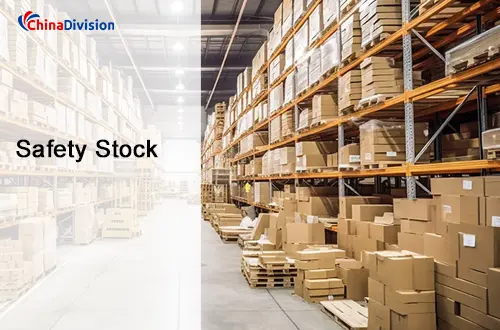How Safety Stock Can Change Your Global Supply Chain?
Inventory management is no longer a trivial matter in the background, but a key factor affecting customer satisfaction, operational efficiency and even profit margins. How to ensure on-time delivery of customer orders in the midst of uncertainty while avoiding warehousing costs that eat up profits? Safety stock, as the "buffer zone" of supply chain management, is the key to solving this problem.
Table of Contents
As an international order fulfillment expert, Chinadivision has helped hundreds of companies optimize their inventory strategies. Let's take a deep dive into the basics of safety stock, its importance, and how to simplify your supply chain while reducing costs.
What is safety stock?
Safety stock, also known as buffer stock, refers to the amount of reserve inventory that exceeds expected demand, and is an additional buffer stock reserved to cope with demand fluctuations (such as promotional orders) and supply delays (such as shipping port congestion and factory shutdowns). Used to guard against the following uncertainties:
Demand surges (such as viral product trends or seasonal surges)
Supplier delays (such as production bottlenecks or customs delays)
Transportation issues (such as port congestion or carrier strikes)

Think of safety stock as an insurance policy for the supply chain. By maintaining an inventory buffer, you can avoid out-of-stocks, stockouts, and sales losses - all of which will damage customer trust and revenue.
What are the core values of safety stock?
Avoiding sales losses
According to research institutions, the retail industry loses an average of 4% per year due to out-of-stock situations (source: IGD), and cross-border e-commerce has a higher loss rate.
Improve customer satisfaction
Stable delivery capabilities = brand reputation, especially in highly competitive overseas markets. Stable inventory guarantees allow customers to place orders smoothly at any time and enhance brand trust.
Smooth supply chain fluctuations
As global logistics uncertainties increase (epidemics, Red Sea crisis, etc.), safety stock is a "moat" to resist risks.
Coping with supply chain fluctuations
Such as natural disasters, strikes, customs delays, etc., safety stock can buy buffer time for companies.
Optimize operational efficiency
Reduce expedited transportation costs and labor costs caused by emergency replenishment.
Safety stock acts as a buffer to ensure that customer expectations can be met even in the event of a disruption. Its core role is to prevent stockouts, ensure that customer orders can be fulfilled in a timely manner, and maintain brand reputation and customer loyalty.
Why is safety stock so important for international order fulfillment?
For cross-border e-commerce and international B2B businesses, supply chain uncertainty is more complex:
International transportation cycles are long and customs clearance is uncertain
Multiple suppliers collaborate and delivery dates are difficult to unify
Market demand fluctuates greatly and promotional activities have a significant impact
In this context, safety stock has become an "insurance mechanism" to maintain fulfillment stability. As a professional international order fulfillment service provider, Chinadivision helps customers accurately set safety stock through intelligent warehousing and inventory early warning systems to avoid sales losses and customer churn caused by stockouts.
Safety stock is no longer "excess inventory", but a strategic resource for companies to deal with uncertainty. By working with Chinadivision, e-commerce sellers and B2B companies can not only reduce warehousing costs, but also realize intelligent inventory management and optimize cost control.
How to determine and calculate safety stock?
Calculating the appropriate amount of safety stock requires balancing risks and costs. Too little inventory is prone to stockouts. Too much inventory means too much inventory capital is tied up.
Here is a simplified formula to get you started:
Safety Stock = (Maximum Daily Usage × Maximum Lead Time in Days) - (Average Daily Usage × Average Lead Time in Days)
Key Variables:
Maximum Daily Usage: The highest number of units sold in a single day.
Average Daily Usage: The typical number of units sold in a single day.
Maximum Lead Time: The longest time it takes for inventory to arrive from the supplier.
Average Lead Time: The typical time it takes for inventory to arrive.
Advanced Considerations:
For a more precise calculation, consider the following:
Service Level Targets (e.g., 95% vs. 99% inventory availability).
Seasonality (adjusting safety stock based on peak times).
Volatile logistics timelines (e.g., port congestion, etc.).
Supplier reliability (probability of delays, less predictable suppliers require more buffer stock).
Frequently Asked Questions about Safety Stock
Does safety stock help reduce shipping costs?
Of course! Avoiding stockouts means you don’t have to make expensive emergency shipments (e.g., air freight). Additionally, consolidating orders with a logistics partner like Chinadivision can reduce shipping costs per item.
What is the difference between safety stock and reorder point?
Safety stock is the reserve inventory you keep on hand. The reorder point is the inventory level at which you trigger a new purchase order (usually safety stock + average demand within the lead time).
How often should safety stock levels be reviewed and adjusted?
Safety stock should be reviewed regularly, at least quarterly, or when there are any significant changes in demand patterns, lead times, or supply chain conditions.
What are the risks of having too much safety stock?
Excessive safety stock leads to increased storage costs, increased risk of obsolete inventory, and tying up funds that could have been used for other investments.
How does Chinadivision help companies optimize safety stock?
Provide inventory forecasts and safety stock recommendations
Multi-warehouse linkage to achieve regional inventory buffers
Real-time inventory monitoring and automatic replenishment reminders
Reduce inventory holding and transportation costs
Improve order fulfillment rate and customer satisfaction
Reduce costs and simplify operations with Chinadivision's fulfillment services
Manually managing safety stock is time-consuming and error-prone, especially when dealing with multiple international markets at the same time. Chinadivision's end-to-end fulfillment solutions can help companies:
Reduce storage fees (warehousing costs) by optimizing storage space and minimizing excess inventory.
Cut transportation costs through batch shipping and regional distribution.
Increase delivery speed by storing products closer to customers.
Are you ready to control your inventory?
Whether you are a B2B supplier or an e-commerce seller, safety stock can effectively improve the resilience of global supply chains. If you want to optimize inventory, reduce storage and transportation costs, and improve the global customer experience, contact Chinadivision today. Partnering with Chinadivision, you will get professional inventory management, cost-effective warehousing services, and seamless order fulfillment services - all of which will be tailored to the unique needs of your business.





